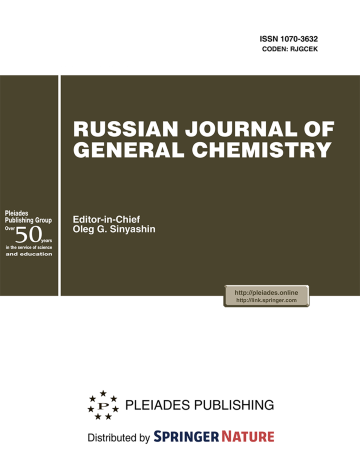New Derivatives of Coumarin-3-carboxylic Acid Containing a Furopyridine Fragment: Synthesis and Some Properties
IF 0.8
4区 化学
Q4 CHEMISTRY, MULTIDISCIPLINARY
引用次数: 0
Abstract
As a result of this study, the first representative of coumarin-3-carboxylic acid containing a furopyridine fragment was obtained. It was demonstrated that this coumarin-3-carboxylic acid readily forms salts with various organic amines, diamines, as well as with alkali metal cations (Na, K) and ammonia. Testing of all obtained compounds against tumor cell lines M-HeLa and HuTu 80 revealed that a number of salt structures (specifically those based on 2-aminopyridine, 2,6-diaminopyridine, or sodium) exhibit cytotoxicity comparable to the reference drug, 5-fluorouracil.


含有呋喃吡啶片段的香豆素-3-羧酸新衍生物的合成及一些性质
本研究获得了第一个具有代表性的含有糠吡啶片段的香豆素-3-羧酸。结果表明,该香豆素-3-羧酸与各种有机胺、二胺以及碱金属阳离子(Na, K)和氨形成盐。对所有获得的化合物对肿瘤细胞系M-HeLa和HuTu 80的测试表明,许多盐结构(特别是基于2-氨基吡啶、2,6-二氨基吡啶或钠的盐结构)显示出与参比药物5-氟尿嘧啶相当的细胞毒性。
本文章由计算机程序翻译,如有差异,请以英文原文为准。
求助全文
约1分钟内获得全文
求助全文
来源期刊
CiteScore
1.40
自引率
22.20%
发文量
252
审稿时长
2-4 weeks
期刊介绍:
Russian Journal of General Chemistry is a journal that covers many problems that are of general interest to the whole community of chemists. The journal is the successor to Russia’s first chemical journal, Zhurnal Russkogo Khimicheskogo Obshchestva (Journal of the Russian Chemical Society ) founded in 1869 to cover all aspects of chemistry. Now the journal is focused on the interdisciplinary areas of chemistry (organometallics, organometalloids, organoinorganic complexes, mechanochemistry, nanochemistry, etc.), new achievements and long-term results in the field. The journal publishes reviews, current scientific papers, letters to the editor, and discussion papers.

 求助内容:
求助内容: 应助结果提醒方式:
应助结果提醒方式:


